Cerberilla pungoarena (Collier & Farmer, 1964) is one of those rare nudibranchs you may never see: only a few subtidal specimens have been reported since the mid-2000s. But now, fifteen years later and further north than they have ever been seen before, a single specimen of C. pungoarena was spotted and photographed a few months ago in shallow water in the Morro Bay Estuary by two intrepid nudibranch enthusiasts, Laura Schachterle and Thomas Hintz.
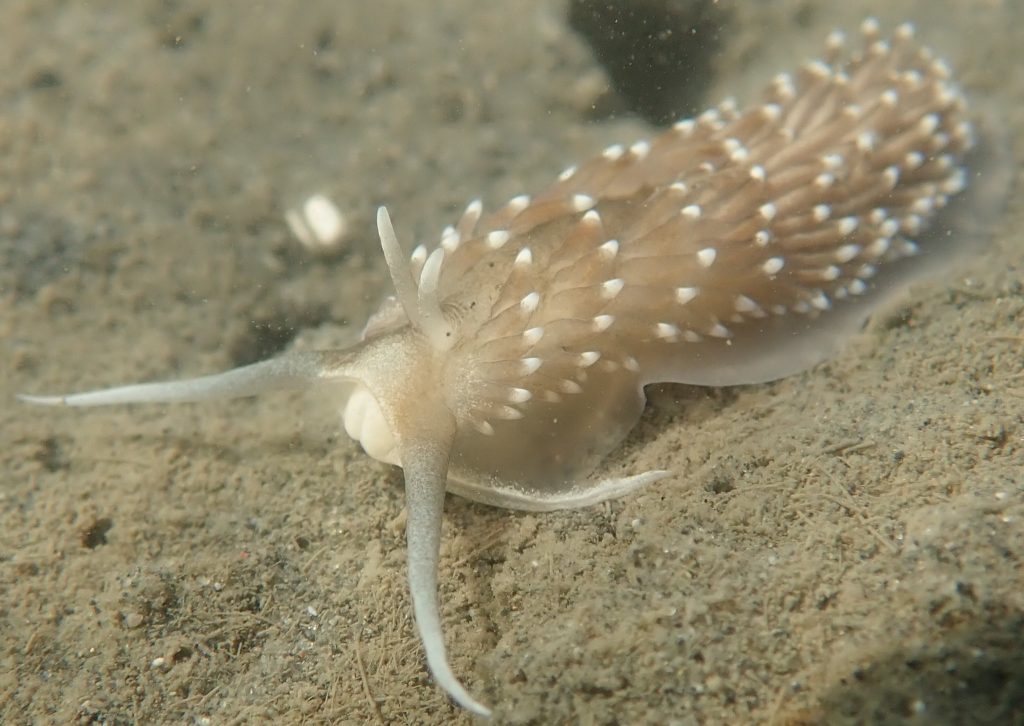
Nudibranchs are shell-less marine molluscs commonly called sea slugs. There are over 130 species of nudibranchs found in California, many brightly-colored.
“Great find and indeed a range extension from the Southern California Bight,” confirmed Dr. Jeffrey Goddard, Midland School and Marine Science Institute, University of California, Santa Barbara. “This species was originally described from the north end of Isla Angel de la Guarda in the central Gulf of California and has been found a handful of times in the San Diego area. Behrens and Hermosillo (2005) list Anacapa Island as the northern range limit, but the only published record of that I can find is Behrens (2004, PCAS 55:50) less specific record, with a photograph on p. 30, from the “Channel Islands” based on a personal communication from Kathy deWit.”
Video of Cerberilla pungoarena moving across the bay bottom, filmed by Laura Schachterle and Thomas Hintz who retain full copyright for this video.
Nudibranch expert David W. Beherens, co-author of Eastern Pacific Nudibranchs (2005), who reported observations of this species in 2004–2005, wrote in 2006 that “it is not uncommon for species of nudibranchs to seemingly come and go. Due to their reproductive strategies, one should expect wide fluctuations in population size. Such is the case with the aeolid, Cerberilla pungoarena. For years after its description, the species was never seen, prompting some to wonder about its validity as a species. In recent years, it has become a common member of California’s sand bottom habitat from San Diego to the Channel Islands.” Little did he know that they would nearly disappear from human view again for another fifteen years.
It was a minor miracle that Schachterle and Hintz spotted the C. pungoarena at all. This was their first visit to Morro Bay, and Hintz found the nudibranch during a −0.2 low tide: “It wasn’t in the shallow mud pools; I found it well past the water’s edge, maybe two feet deep in the water, which was kind of murky,” he said of the estuary’s often silty, near-opaque water. “This time the murk would kind of come and go, so I would kind of follow the clearer parts. It was out in the open on top of the sand.” The following day, they tried again, but the water was completely silty.
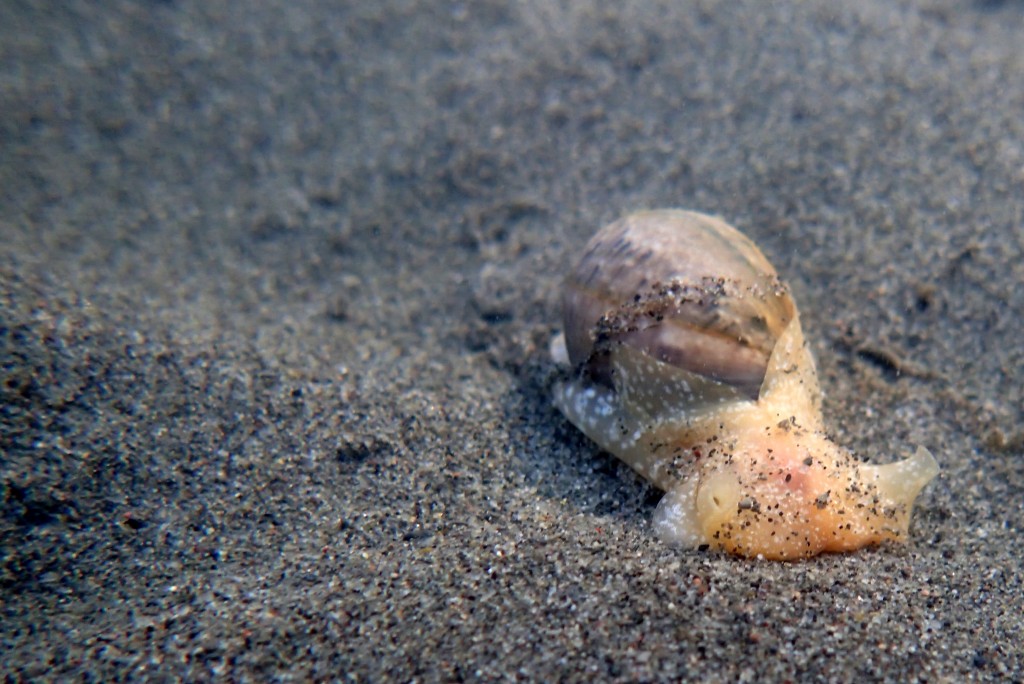
“I was looking at a Bulla gouldiana [a headshield slug species] when Tom said, “I found a slug, I don’t know what it is,” said Schachterle. “And that’s usually a good sign! When he brought it over, I knew it was a Cerberilla, though I thought it was C. mosslandica since that’s the one I knew about. It had eyespots, and its rhinophores were close-set and really short, though its oral tentacles were really long. The way I knew it was a Cerberilla was its ‘boat body,’ basically, the way its foot sticks out way past the cerata. When I looked in ‘The Book’ [Behrens & Hermosillo’s Eastern Pacific Nudibranchs (2005)], I saw that it didn’t look like C. mosslandica, and then I saw the photo of C. pungoarena and I said, ‘That’s it!’ It was very clear that that was what it was.”
Video of Cerberilla pungoarena moving quickly, filmed by Laura Schachterle and Thomas Hintz who retain full copyright for this video.
Added Hintz: “Sometimes with rarely seen species it can take a while to do the research and figure out the IDs but this time was immediate: ‘It’s this one!'” Schachterle posted her photos on iNaturalist.org to the delight of many other nudibranch enthusiasts and professional scientists who use the citizen scientist platform to log their observations and share data.
This nudibranch’s scientific name refers to the way it glides over sand, something Schachterle and Hintz noticed as well. “When I set it down and let it go, it was really cool because it was super active: going like THIS with its oral tentacles [she gestures with her hands] and feeling its way across the surface,” Schachterle said. “It produced a lot of slime or mucus to get through the sand. You could see strings of mucus coming off of it. When it would dig, you could see the strings of slime so it could bury itself smoothly. It used its mouth and oral veil like a shovel, it was so cool.”
She continued: “At one point it might have been digging for food, because it burrowed a little way down and then came back up. I read that Cerberilla species eat burrowing anemones; it was so great that we got to watch it doing its thing in its natural habitat for a while.”
In this video, the Cerberilla pungoarena displays the digging behavior described by Schachterle. Video copyright by Laura Schachterle and Thomas Hintz.
Schachterle and Hintz travelled from the San Francisco Bay Area to Morro Bay specifically to look for nudibranchs, particularly the showy blue-and-gold Antiopella barbarensis more commonly seen in Morro Bay during the summer and fall. They didn’t find one, but saw Dendronotus venustus, Orienthella trillineata and Hermissenda opalescens as well as many Philine sp. and headshield slugs.
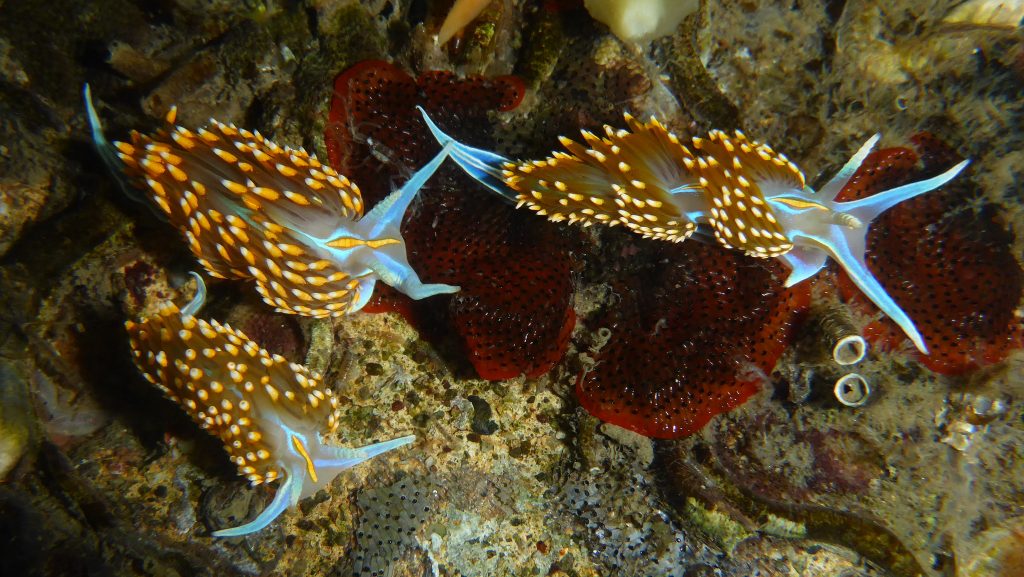
“We became interested in nudibranchs at the same time,” Schachterle said. “We love going tidepooling. At first, we didn’t know anything, just went out whenever we were by the ocean, with no regard for how low the tide was or anything. One time, we were at Fitzgerald Marine Reserve and one of the docents pointed out two nudibranchs, a Hopkins’s Rose and a San Diego Dorid, and we were hooked. Score one for the docent program there.”
They came prepared for the Morro Bay Estuary, too. “We had our boots on, hip boots and waders,” said Hintz. “I would kind of get sucked in around an area and just sit there looking for a while.” Added Schachterle: “We didn’t get stuck, but the challenge is keeping your balance once one foot is stuck, because you can’t shift from one foot to another. There were a couple of times I almost fell over for sure.”
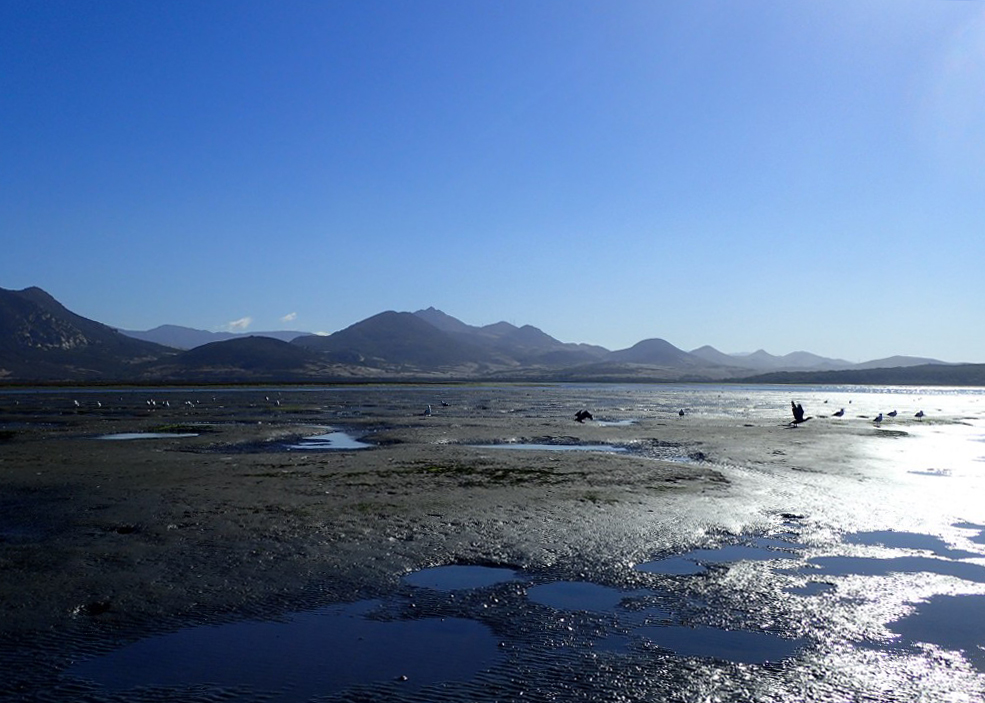
Tips on Morro Bay nudibranch viewing? “Locals who have an interest in nudibranchs are lucky, there are so many species to see in Morro Bay,” said Schachterle. “Just don’t get stuck.”
Guest Author, Robin Agarwal
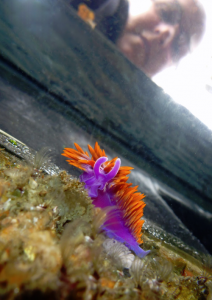
Lying flat on a bouncing floating dock underneath one of the biggest tourist-attraction piers in California, with my head and arms hanging over the side, I am frequently reminded of the kindness of fellow humans who think I’ve had a stroke or dropped my phone. No—just photographing sea slugs! I point, and show them a few photos on the back of my cheap underwater macro camera, and presto, another nudibranch enthusiast.
I was a tidepool kid who went astray and graduated with a liberal arts degree. In the last decade, I’ve returned to the tidepools and found a particular passion for photographing nudibranchs and other intertidal marine life. I’m co-editor of the California Sea Slugs Guide, and the Dock Fouling in California project on iNaturalist.org, where I have posted about 4,000 geotagged observations of nudibranchs, mostly along the Central California coast. Since I offer all my photos free to non-profit organizations (my way of thanking them for the work they do), you can find them all over the internet as well as Bay Nature magazine and NOAA National Marine Sanctuary informational signage. I’ve also been an enthusiastic contributor to a few scientific papers on nudibranchs, most recently Heterobranch Sea Slug Range Shifts in the Northeast Pacific Ocean Associated with the 2015-16 El Nino by Goddard et al. (2018).
Subscribe to our weekly blog to have posts like this delivered to your inbox each week.
Help us protect and restore the Morro Bay estuary!
- Donate to the Estuary Program today and support our work in the field, the lab, and beyond.
The Estuary Program is a 501(c)3 nonprofit. We depend on funding from grants and generous donors to continue our work. - Support us by purchasing estuary-themed gear from ESTERO. This locally owned and operated company donates 20% of proceeds from its Estuary clothing line and 100% of Estuary decal proceeds to the Estuary Program. Thank you, ESTERO!
- Purchase items from the the Estuary Program’s store on Zazzle. Zazzle prints and ships your items, and the Estuary Program receives 10% of the proceeds. Choose from mugs, hats, t-shirts, and even fanny packs (they’re back!) with our fun Estuary Octopus design, our classic Estuary Program logo, or our Mutts for the Bay logo.